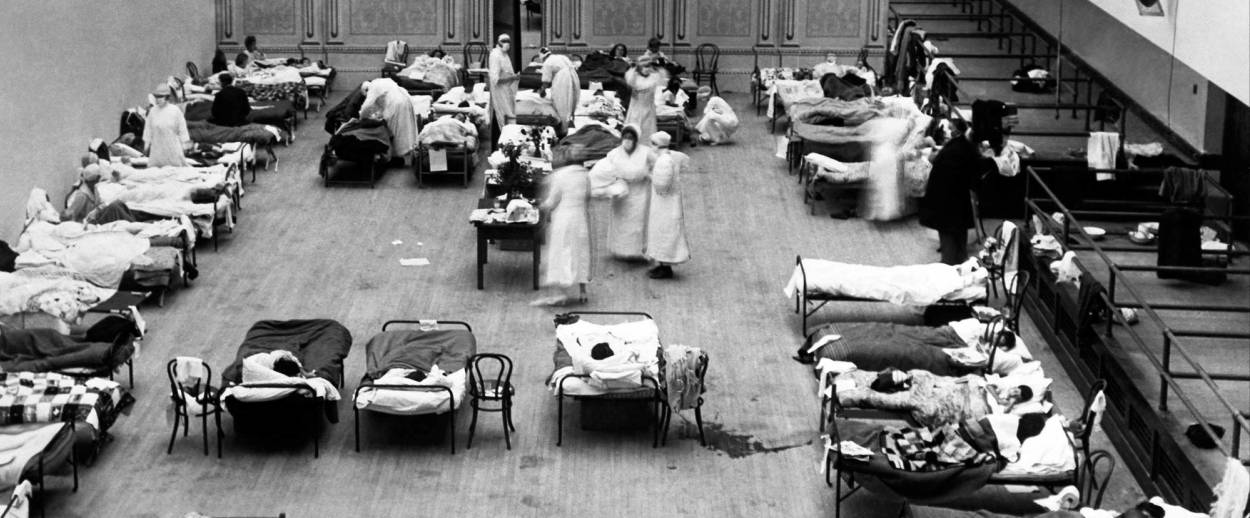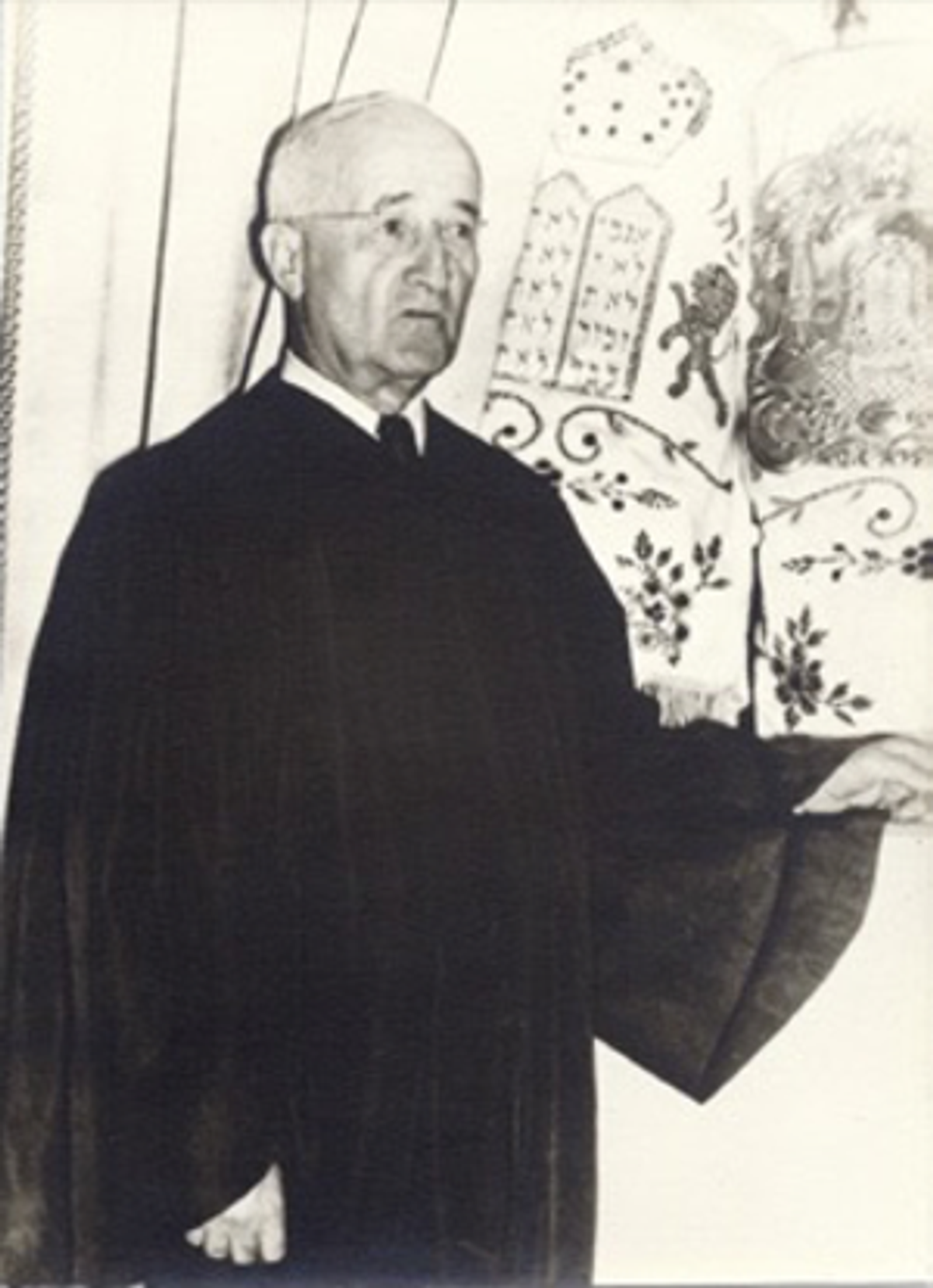Beating the Flu
A century ago, Rabbi Moise Bergman helped the people of Albuquerque survive a deadly epidemic




One hundred years ago, as the so-called Spanish flu took hold of much of the nation, the commissioners of Albuquerque, New Mexico, declared a state of emergency. The city, which had a population of under 15,000 at the time, had been devastated by 923 cases of influenza and 167 deaths. One of the most passionate proponents of a citywide quarantine—including closing the railroad—was Rabbi Moise Bergman of Albuquerque’s Congregation Albert. It was not a position that pleased all of his followers: Many of the members of the Reform congregation, established in 1897, were retail merchants whose livelihoods depended upon railroad traffic. Nor was a quarantine popular among candidates for political office in an election year.
But the quarantine ultimately helped protect the city during the height of the epidemic. And Bergman’s activism—including operating an emergency hospital for the poor and raising money for those widowed or orphaned by influenza—ultimately won him the support of his congregants, fellow clergy, and the community at large.
*
Bergman was born in Louisiana in April 1878, the son of a businessman. After receiving rabbinical training at the Hebrew Union College in Cincinnati, Bergman took the pulpit of the Gates of Prayer congregation in the city of Lafayette, Louisiana, in 1906. In 1911, then-rabbi of Congregation Albert, Mendel Silber, switched pulpits with Bergman, whose wife, Joycie Kamien Bergman, was ill and perhaps required a drier climate; just two years apart at Hebrew Union College, it is likely that Bergman and Silber were friends.

When Bergman took the pulpit, Congregation Albert was the only synagogue in Albuquerque. In addition to tending his congregants, Bergman was a sought-after speaker and active in the Albuquerque community, serving as secretary and later president of Albuquerque’s ecumenical Board of Charities. By all measures, Bergman was respected by his fellow clergy, some of whom even called upon him to take their pulpits during absences, as he did with the Methodist Episcopal Church in Santa Fe.
In August 1918, Albuquerque was more focused on news of the war than on the threat of influenza, and Bergman was busy selling Liberty Bonds and planning a community rally to honor General Pershing. According to reports, the flu outbreak in the region began in Carlsbad and Gallup, New Mexico. By September and October, cases began to emerge in Albuquerque, the state’s largest city, leading to restrictions on indoor meetings and railroad traffic, as well as school closures and the quarantine of stricken students at the University of New Mexico.
Under the direction of Bergman and the Board of Charities, a colony of TB patients was already receiving food and medical treatment. In response to hospital crowding, the organization converted the TB colony into a makeshift hospital for flu victims. When the outbreak taxed the organization beyond its financial capacity, Bergman turned to the papers to ask the public for donations of food and medicine, adamant that the poor were suffering disproportionately. He ultimately raised $10,000 for the children and women who were orphaned or widowed as a result of the flu epidemic.
As the month marched on, the only exception made for a public gathering was the armistice parade and celebration—marking the end of the war—which began the night of Nov. 11 and lasted well into the next day.
Albuquerqueans, regardless of age, nationality or sex, joined almost as a unit in giving vent of their feelings of joy of the signing of the armistice by the Germans. Celebrations may come and celebrations may go, but none will surpass in enthusiasm the one held here today.
—Albuquerque Journal, November 12, 1918
One might also speculate that the revelers were overjoyed to gather and celebrate in a public setting after at least of month of isolation.
Citing the recent deaths of two schoolchildren in the preceding 24 hours, on Nov. 19, 1918, city commissioners extended their earlier quarantine. Bergman adamantly supported their decision.
It is hard to answer the man who says his business has been hurt by the quarantine but it will be impossible to answer the one who says my child has died because of the neglect of the state. –Rabbi Bergman, Albuquerque Journal, November 26, 1918
Bergman did not exaggerate. The flu was more deadly for the state’s residents than the entirety of WWI, in which 215 New Mexicans were killed in action. Of the 15,000 New Mexicans who contracted the flu, more than 1,000 ultimately died in the epidemic, according to the New Mexico Office of the State Historian. Obituaries of flu victims filled the papers.
Benjamin Menke, age 16, died at home from pneumonia (a complication of the flu). His sister, Lydia, age 18, died two days earlier of the same disease.
—Albuquerque Journal, November 20, 1918
Despite the danger, there was still not universal support for extending the quarantine. City commissioners were threatened with a recall. Businesspeople were impatient, including Bergman’s own congregants. J.A. Weinman, proprietor of the Golden Rule Dry Goods Co. was quoted in an Albuquerque paper stating that “further restriction is entirely useless.” S.U. Rosenwald, another prominent merchant, was more reserved, asserting, “This is a matter that should be left in the hands of the authorities.”
Luckily, by Dec. 1, quarantines and other restrictions against public meetings were lifted completely as the number of flu cases dwindled. Customers returned to shops and theaters, reportedly “frisky as colts just turned out to pasture.” As for Rabbi Bergman, he continued serving at Congregation Albert, on the Board of Charities, and as president of the state board of the Salvation Army.
In 1922, Bergman was honored by the Albuquerque Chamber of Commerce, at which University of New Mexico President David Hill noted: “To all citizens … whether they be Protestant, Catholic, or Jew, Dr. Bergman is best known as a leader in civic betterment.”
New Mexico author Erna Fergusson memorialized the community’s affection for Bergman in her 1947 book, Albuquerque, in which she shares an exchange between a parish priest, Father Mandelari, and Rabbi Bergman over how to handle a surplus of funds.
The [charity] committee had done its job and found extra money on hand. It met to decide what to do with the surplus cash. Father Mandelari, dean of Albuquerque’s clergymen and beloved by people of all denominations, rose. “Gentlemen and ladies, I move you that this extra money be used to buy a Christmas present for Rabbi Bergman.” The rabbi, equally popular and quick, though much younger, leapt to his feet. “No, no,” he cried. “I offer a substitute motion. I move, Mr. Chairman, that we apply this surplus to the purchase of a wedding present for Father Mandelari.”
By February of 1919, there were calls for a New Mexico state Department of Health to be established but not everyone was convinced. Albuquerque’s Evening Herald editorialized on Feb. 20: “We have been through an epidemic of war and influenza. Perhaps we are a little overwrought upon the dangers that menace the health of our people.” Nevertheless, less than a year after the height of New Mexico’s flu epidemic, a state Department of Health was organized under the direction of a former assistant U.S. Surgeon General.
Bergman’s efforts on behalf of the city were so appreciated that when he attempted to resign his pulpit in 1920, it was front-page news. Congregants would not accept the rabbi’s resignation. Louis Ilfeld, Congregation Albert’s president stated, “We felt it would be a serious loss not only to Congregation Albert but to Albuquerque and New Mexico as well.” Three years later, Bergman did leave Albuquerque for a pulpit in Pueblo, Colorado, moving later to lead a congregation in San Diego. He passed away in 1948 at age 70, leaving a legacy of social activism and community service.
***
Like this article? Sign up for our Daily Digest to get Tablet magazine’s new content in your inbox each morning.
Naomi Sandweiss is the author of Jewish Albuquerque, and a past president of the New Mexico Jewish Historical Society.